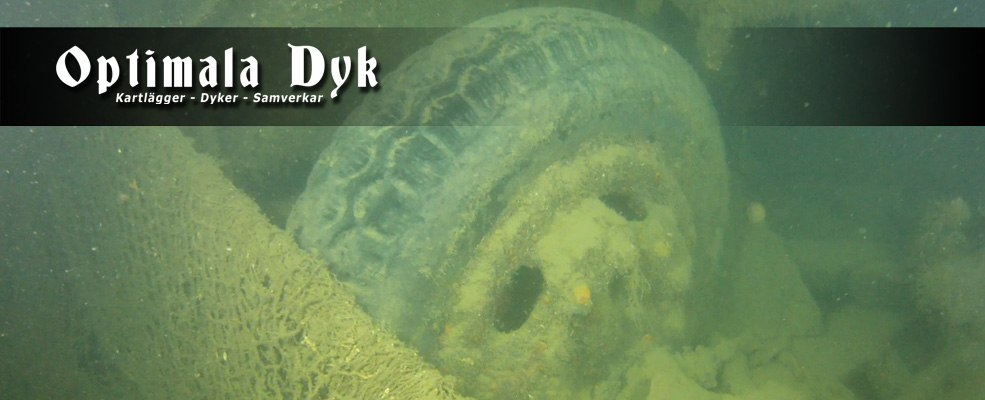Midget submarines type Molch in the Kattegat
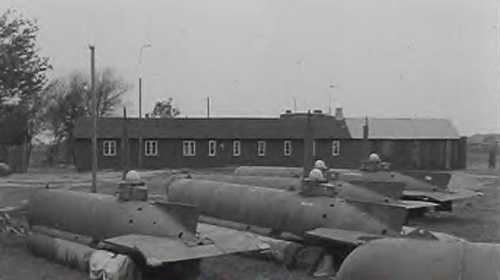
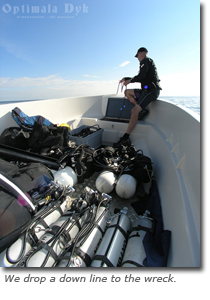 During the night between the 9th and the 10th of April 1945 a unit of German ships was on its way across Kattegat to Norway. One of the ships was carrying a cargo of midget submarines of the type Molch. In the early hours of the 10th of April the unit was half way up through the sea of Kattegat. The German ships were spotted by allied bombers and soon after, they engaged the German vessels close to the island of Läsö. The attack lasted until about 0245 hrs. About twenty minutes later the cargo ship, with a length of about a football field, had been sent to the bottom of the sea, along with its cargo of midget submarines.
During the night between the 9th and the 10th of April 1945 a unit of German ships was on its way across Kattegat to Norway. One of the ships was carrying a cargo of midget submarines of the type Molch. In the early hours of the 10th of April the unit was half way up through the sea of Kattegat. The German ships were spotted by allied bombers and soon after, they engaged the German vessels close to the island of Läsö. The attack lasted until about 0245 hrs. About twenty minutes later the cargo ship, with a length of about a football field, had been sent to the bottom of the sea, along with its cargo of midget submarines.
In July 2011, we went out to the cargo ship with the midget submarines. We have dove on the wreck before, but this time it was going to be extra special. Our goal was to document what is left of the ships cargo, the midget submarines type Molch. Are the submarines still intact after almost 70 years on the bottom of the sea? Or has the time in the salty water broken down all signs of them? To find out we were going to dive deep inside the ships cargo holds and take video footage of the cargo.
The dive
Early in the morning we arrive at the wreck site. As we pass over the wreck with our boat we let the slow current take us over the area. On our sonar we can see the massive ship standing on the sea floor. We take our boat up to the point where we want to place our down line and when we reach the spot, the line with its weight is dropped down through the deep water.
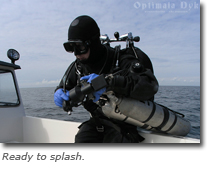 We put our kit on. The air temperature is about 30 degrees Celsius and we can feel the sun burning in our faces. As soon as we are geared up we do the last checks. We then rise up and take a few steps towards the railing of our dive boat. We roll in to the water and make our way to the down line. Here we receive the video gear from the boat crew. There is no current at the surface and we can relax for a moment, focusing on the dive we are about to do.
We put our kit on. The air temperature is about 30 degrees Celsius and we can feel the sun burning in our faces. As soon as we are geared up we do the last checks. We then rise up and take a few steps towards the railing of our dive boat. We roll in to the water and make our way to the down line. Here we receive the video gear from the boat crew. There is no current at the surface and we can relax for a moment, focusing on the dive we are about to do.
Between 15 and 20 m we pass through a pycnocline with really bad visibility. Under this the visibility gets better but as we go deeper down along the line the sunlight has harder to reach down through the water column. 40 m… 45 m… 50 m… 55 m… As we go deeper it gets darker… and colder. At the surface the temperature was close to 20 degrees Celsius. Now it has dropped to 7.
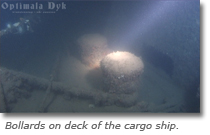 After descending for about four minutes we arrive at our destination: A German cargo ship of World War Two. It is dark but in the beams from our lights we can see that we have come down among some trawl nets, lines and fallen masts. The old trawl nets and lines, embracing the wreck, give the place a bit of a spooky feeling. The visibility is about two metres. There is a layer of silt across everything on the wreck. As we make a primary tie off, close to our up line, some of the silt is disturbed and a cloud of loose sediment is released into the water, limiting the visibility to an arms length. We move out of the disturbed area
After descending for about four minutes we arrive at our destination: A German cargo ship of World War Two. It is dark but in the beams from our lights we can see that we have come down among some trawl nets, lines and fallen masts. The old trawl nets and lines, embracing the wreck, give the place a bit of a spooky feeling. The visibility is about two metres. There is a layer of silt across everything on the wreck. As we make a primary tie off, close to our up line, some of the silt is disturbed and a cloud of loose sediment is released into the water, limiting the visibility to an arms length. We move out of the disturbed area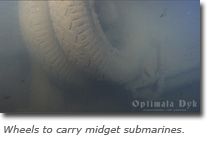 and take a moment to take in the environment and to orientate ourselves.
and take a moment to take in the environment and to orientate ourselves.
We are on the starboard side of the wreck. The depth is about 65 m. We make an ok sign to each other to signal that we are ready. We move across the deck and find the entrance to the cargo hold we believe is holding the midget submarines. Across the opening to the cargo hold there are some old trawl nets and fishing lines are hanging from some fallen masts across the entrance to the cargo hold. The beam of our lights hit a ladder going straight down the cargo hold. We sink down into the dark cargo hold. We come across some big wheels and soon we spot what is lying on the wagon: A midget submarine! Here the depth is about 75 m.
Facts about Molch.
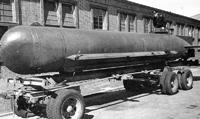
The midget submarine type Molch was a submarine exclusively driven by electricity. The submarine carried two G7 torpedoes, one on each side of its body. The submarine had an overall length of almost 11 m. The batteries, used for energy to propuls the vessel, made up most of the submarines body. The capacity of the batteries gave the Molch an operational range of about 65 km at 4 knots. Behind the batteries, the operator was placed and behind him was the electric motor. All together 393 Molch were built,the first delivered from the shipyard AG Weser in Bremen in the summer of 1944. However, even though the type Molch saw action and managed to sink a few allied vessels, the type Molch were not very successful. Eg it was a challenge with the stability and it was hard to dive, and therefore vulnerable to the enemy.
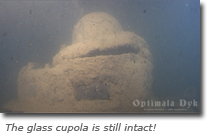 We notice there are several midget submarines in the cargo hold. We place ourselves above one of the midgets to help lightening up the submarines. We have to be careful not to disturb any sediment that will spoil the visibility in a second if it is touched. We back off with the camera a bit, maybe two metres from the sub and manage to get some good video footage. The glass cupola, where the submarine operator was meant to sit and look out when he carried out a mission, is still intact.
We notice there are several midget submarines in the cargo hold. We place ourselves above one of the midgets to help lightening up the submarines. We have to be careful not to disturb any sediment that will spoil the visibility in a second if it is touched. We back off with the camera a bit, maybe two metres from the sub and manage to get some good video footage. The glass cupola, where the submarine operator was meant to sit and look out when he carried out a mission, is still intact.
We then move around, taking some more footage of the sub. Finally we let the camera follow the whole length of the sub.

We turn the dive and start making our way out along the line. We return to the up line where we give each other the old up sign and start our ascent.
As we slowly drift away from the wreck, its dark, massive structure is fading away in the water. About an hour and a half later we break the calm flat surface.
